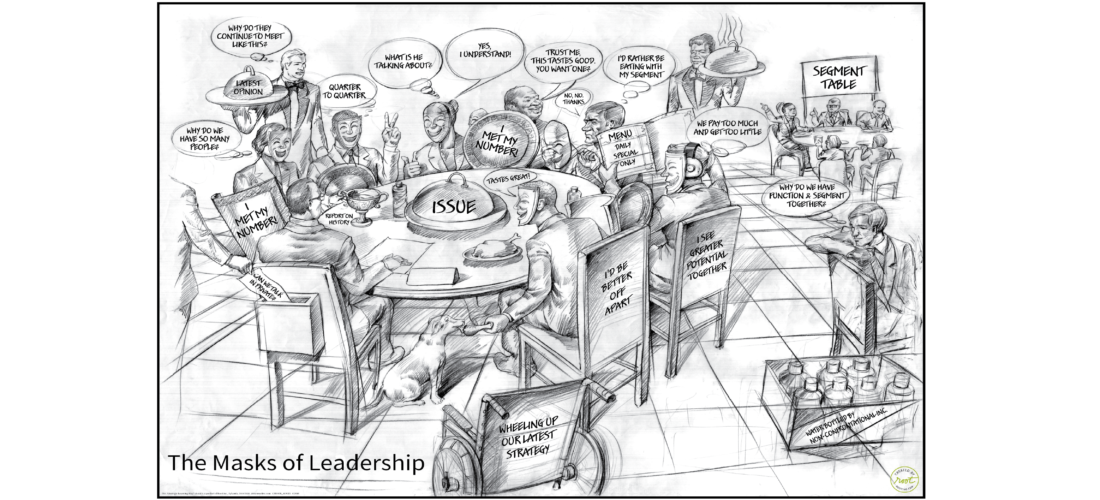Dialogue is at the root of all effective engagement and group action. This statement seems straightforward enough. Communicate with your peers and teams and you’ll be effective! Surprisingly, however, it’s not that simple. Real dialogue at work—the exchange of thoughts where each person has equal opportunity to be heard—is far less common than you might think.
It seems contradictory, as the art of conversation has been happening for as long as humans have existed, with tribes sitting around fires, often for days at a time, and coming to conclusions together, as a unit. In 2019, we should have mastered the art of the group conversation by now. However, leaders are still struggling to learn how to successfully think together.
Leaders struggle to foster real dialogue.
The heart of dialogue is listening. This requires us to not just hear others’ words but to also hear our own thoughts, which can change when we are truly able to receive others’ input. But first, we must take pause in our responses to deeply consider what others are saying to us. This isn’t easy. It takes effort. Often in conversations, we aren’t listening to what is being said because we’re reloading. It takes practice to quiet our inner thoughts, which often distract us from hearing what others are saying or even recognizing our own reactions.
Here’s the problem when it comes to dialogue and listening at work. The times when we need to be the most conscious of others are when things get chaotic, stress levels run high, and deadlines loom. However, this rarely happens. Instead, during the most critical times, we are more likely to forget that nurturing and sustaining conversations could be the solution! Turning to our groups and synthesizing challenges together has the potential to penetrate and dissolve some of our most difficult problems. Instead of leveraging the power of the whole, too often our conversations fail us. Instead of creating something new, we polarize, take our opposing positions, and fight.
Leaders need to actively encourage collective intelligence.
When we learn to actually hear what is being said around us, collective intelligence is attainable, and this is truly powerful. Gathering others’ perspectives in the pursuit of landing on a new perspective is groundbreaking for you as a person and as a leader.
To achieve collective intelligence, leaders must change a few behaviors to create environments where real dialogue can occur.
- Retire your PowerPoint presentations.
It’s time to accept that rational and logical presentations, such as the traditional PowerPoint, don’t work. They won’t spark the interest among people that leads to open and honest conversations. They actually do the opposite! When you use facts, fear, and force, the side effect is people not caring. This approach is a sure yawn. People don’t want to be given all the answers. It’s time to start asking your people the most strategic questions and not just presenting them with the most strategic answers.
- Leverage storytelling and visuals to kick-start real dialogue.
When you stop using PowerPoint presentations to communicate with your people, you will have the opportunity to turn to powerful storytelling and visuals. These techniques will elicit emotions in your people that will motivate them to give and engage with your strategy. Consider this scenario. Instead of showing your people a PowerPoint presentation in an all-company meeting, what if you shared a visual that depicted the roles of leaders, managers and doers; split people into small groups; and gave them the safety, time, and tools to share their real thoughts and opinions? You would provoke the fire of conversation! People would participate in real dialogue. They would become engaged. Now, you’re headed in the right direction.
- The best leaders are the creators of creators.
The most successful leaders realize their people will come up with better solutions than they could ever script for them. To be a great leader, you must believe your people can solve your biggest problems better than you ever could. After all, you’ve hired the best, right? Instead of gathering the C-suite to synthesize a solution, what if you started taking your most critical challenges to your people and encouraged co-thinking and collective intelligence? You better believe they will be able to come up with great answers to those challenges. The best leaders are the creators of creators.
Engagement will shift for the better when people have the opportunity, safety, and tools to properly engage with each other.
The issue of employee engagement is real. It seems unsolvable. But the three actions above are simple, yet incredibly effective and impactful ways to make changes within your organization. And it all begins when leaders understand that achieving engagement isn’t about messaging or one-dimensional storytelling. Instead, it’s about letting people become participants and co-crafters of the story.
Leaders, things will start to shift when you recognize that you need to unleash the dormant human talent of your people. When you do this, their response far exceeds anything you could create for them. Give your people the opportunity to work together on core organizational challenges. Teach them how to partake in real dialogue with you and each other. Show them the value of collective intelligence by exhibiting this mindset yourself. You will be rewarded with creativity, innovation, passion, and ingenuity you couldn’t otherwise uncork.






